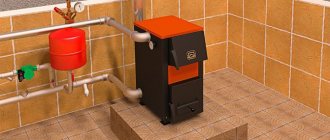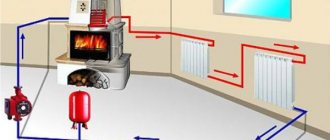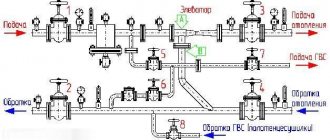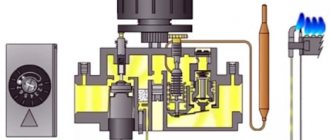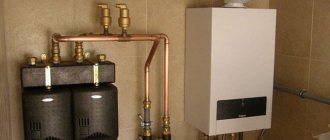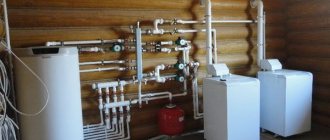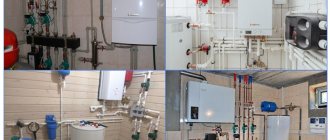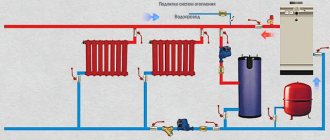Here you will learn about heating in an apartment in an apartment building: installation diagram and installation of devices in the room, heating of common areas, how to install gas heating in one-room and two-room apartments.
Taking into account the cost of heat supply services, the most popular topic of discussion among the population today is their quality and options for getting rid of the “tutelage” of managing farms.
In fact, the heating system of an apartment in an apartment building is not always a sad story with a bad ending.
Centralized heating of a city apartment can not only be adequate, but also be adjusted to suit the needs of consumers.
District heating structure
Millions of people, being owners of apartments, thereby become “hostages” of public utilities. This has to do with paying for heating in an apartment building and more. What can we say to those who are concerned about the issue of heating a 3-room apartment. To save money, residents should know how heating works in an apartment building and what actions or devices will help them with this. What to do if you have poor heating in your apartment? You need to complain to the relevant services. Read more about this here.
If you pay attention to the heating scheme of an apartment in multi-storey buildings, it is the same almost everywhere:
- At the thermal station, the coolant (for multi-storey buildings - water) is heated in special boilers to a temperature of +130 -150 degrees.
- To avoid the formation of steam, it is further supplied through heating mains under high pressure to residential buildings (you can find out more about the operating pressure in the heating system of an apartment building on our website).
- Valves are installed at the entrance of the heating main pipe to the house, allowing you to control the level of water supply to its heating circuit.
By the way, if you have radiators in your apartment or you decide to install them, then we advise you to familiarize yourself with the important questions that you may have: how to choose the right radiators, replacement and adjustment, service life and repairs, flushing heating systems, diagrams and methods connections, types of radiators and their installation, noise in the radiators, as well as what should be the temperature of the heating radiators in the apartment.
Further distribution of the coolant depends on how the heating of the apartment building (residential) is supplied, that is, what is the design diagram of the heating system:
- Single-pipe apartment heating (2017), for all its attractiveness in the form of low price and reliability, is not the most popular type of heating system.
This is due to the fact that the coolant passes through all the risers and radiators of the building through one pipe, and only then returns through the return line for heating and subsequent circulation. If water is supplied from above, then the hottest radiators will be on the last floors, while on the first they are slightly warm, and, vice versa, when supplied from below. Fortunately, this type of connection is rare today. Read about what the temperature of heating radiators in an apartment should be on our website. - The two-pipe system has clear advantages over its one-pipe counterpart.
The coolant does not have to go through such a long and winding path, since when it gets hot into the radiator, it almost immediately passes into the return pipe, from where it runs back to the heating station. The only drawback of the system is the larger number of pipes, which means more costs, but they are paid off by the uniform distribution of heat throughout all rooms of the building. Find out more about the layout of heating pipes in an apartment, as well as how to properly hide the pipes.
IMPORTANT! It is on a two-pipe system that heat meters can be installed and the heating temperature of radiators can be controlled. If necessary, it can be reduced, creating significant savings. By the way, a circulation pump will also help save money. Read about how to choose it correctly and how it works here.
As the practice of recent decades has shown, centralized heating in an apartment has ceased to be a “sentence”, since it has become possible (not for everyone!) to switch to individual heating of housing (read more on our website on how to refuse central heating in an apartment building). In addition, it can be used to heat the bathroom. Autonomous heating in an apartment seems to be an ideal option; read more about it in the next section.
Pipe routing
Depending on what designs and number of pipes were chosen, several types of wiring are classified: two-pipe, manifold, single-pipe and plinth.
At the same time, there are four ways to make a contour:
- Hidden method: pipes are placed in the walls;
- Open method: requires less money and time;
- Vertical method;
- Horizontal method.
Heating system
Many residents of high-rise buildings dream of equipping their apartment with their own boiler room or underfloor heating system, abandoning the central heating of their apartment in Moscow. According to the law, if the heating system in the house allows this, then the apartment owners can begin the refusal procedure (find out exactly how to transfer the apartment to individual heating on our website). It is important to know how to heat the apartment and what conditions must be met.
Before you think about what type of heating to install in your apartment, you need to collect all the necessary documents to dismantle the old equipment. Among them should be not only a technical passport, documents for ownership and an application, but also a new project for installing heating in the apartment.
The latter should be drawn up only after the commission has concluded that the apartment can be transferred to autonomous heating without causing damage to the other residents of the house and the centralized heating system as a whole.
IMPORTANT! The refusal procedure may take several months, so you need to be patient, and while visiting the offices, think about how to properly install heating in the apartment.
Individual heating has its advantages:
- Creation of the necessary microclimate.
- Regulation of heat supply and its quality.
- Turning on the system when you really need it.
- An ideal option for heating corner apartments.
But we must not forget that although you no longer have to deal with utilities, no one is exempt from paying for heating common areas in an apartment building.
Heating option for a two-room apartment (diagram):
Compliance with the law during installation
The legality of using an autonomous unit to supply heat to a separate apartment gives rise to many disputes. In 2010, disconnection from the general heat supply main was prohibited by the Russian government. The installation of individual complexes for heating rooms in multi-storey buildings is also blacklisted.
But in 2012, a new decree on regulations for connecting heating systems provided a list of heat sources prohibited in an apartment . Certified heating boilers are not indicated in this list. From now on, it is allowed to install individual heating in your own living space. Restrictions affect the technical characteristics of the units.
Free independent placement of heating devices and re-equipment of the existing pipe system are not allowed. To obtain a permit, contact the local municipality. Sometimes Art. 14 of the Federal Law “On Heat Supply”. In this case, the apartment owner has the right to appeal to the courts.
In this video we will look at a gas boiler in an apartment:
Heating of common areas
Heat in hallways is another burden on consumers’ wallets. Since staircases, technical floors, basements or attics are part of a centralized heating system, the heat they receive must be paid for.
Unfortunately, a situation often occurs when the radiators in the entrance are heated, but it is cold inside. This is due to the fact that no one took care of reducing heat loss. Poorly closing entrance doors, lack of glass in the entrance windows, all this “eats up” the heat, for which the residents themselves have to pay.
Heating network workers must ensure that the heating in the entrance of an apartment building works effectively. In high-rise buildings, batteries are located on the ground floor and on all subsequent staircases in special niches.
If the system is outdated, then the service in charge of heat is obliged to replace it at its own expense, as well as carry out other work to prepare for the winter season:
- insulate windows and balcony doors;
- replace broken glass;
- insulate the attic, if there is one, and the pipeline;
- check the heating system before starting it;
- repair entrance doors and insulate them.
If such work is not carried out and it is cold in the entrance, residents have the right to file a complaint against the management company and demand a recalculation for communal heating.
First start
The first start-up of a wall-mounted gas boiler must be carried out by a certified specialist. He will make all the necessary settings and check the operation of the system (more details: “How to start a gas boiler for the first time”). During the commissioning process, you have the opportunity to ask questions to a professional on the use of gas heating equipment. After completion of the commissioning work, a certificate is signed.
Thus, we can draw the following conclusion: the installation of wall-mounted gas boilers cannot be called simple. It requires relevant experience in the construction, installation and plumbing field. At some stages it will not be possible to do without the participation of specialists. But if you complete a number of steps yourself, then you will be able to save a lot of money.
Video examples of installation of a wall-mounted gas heating boiler:
Basements
As a rule, initially basements in apartment buildings were planned as a place where all the nodes of heat and water communications were collected, ventilation also took place here, and the central sewage system of the building was located.
Currently, basements are often converted into cafes, gyms or shops. Heating the basement of an apartment building is part of a centralized system, which heating network technicians are required to look after. To prevent it from becoming a “black hole” in the budget of the house, it should be carefully insulated and this should be done, as in the entrance, by the heat supplier.
Residents of the building have the right to check how well the work has been done , since they are the ones who pay all the costs for heat, regardless of whether there is a common building meter or not.
Apartment heating
An apartment with apartment heating is an innovation in new buildings. This term means that the house will not be connected to a centralized heating system.
Such houses began to appear more and more often for several reasons:
- The developer saves significantly , since he does not need to draw up a project, coordinate it with the heating network, carry out communications and install heating radiators.
- Clients also like this approach of developers. The price of housing is significantly lower , independence from utilities and the ability to independently choose how to heat, all this makes the apartment more attractive.
IMPORTANT! Autonomous heating is currently a privilege not only for residents of new buildings, but also for old high-rise buildings. Although obtaining permission is troublesome and sometimes difficult, any owner can insist on their right to decide how to heat their home, even through the courts.
In many modern new buildings, heating in the apartment is pre-installed using a double-circuit gas boiler, which is included in the price. This somewhat limits the choice of customers, but on the other hand, gas heating has its advantages.
Single-pipe system "Leningradka"
"Leningradka" is recognized as the most reliable heating system. Also refers to the natural type of circulation. Considering the ease of assembly, the price/quality ratio, and the efficiency of heating the room, this is the best wiring option at the moment. This scheme is a system of series-connected heating batteries with one pipe. The coolant is heated using a boiler. This option is ideal for small cottages using a pump to circulate the liquid.
Heating in the apartment: gas
If you believe today's statistics, then gas is still the cheapest type of heating in the country, and if you compare the prices of centralized heating and autonomous gas, then the latter is 3 times cheaper for the same heating of indoor air.
Installing gas heating in an apartment building has the following advantages:
- The consumer pays only for the cubic meters of fuel actually spent on heating. To keep the amount payable as low as possible, you need to purchase the most economical boiler, which is not difficult, since their choice on the market is huge.
- Since the consumer does not experience heat loss due to the transportation of coolant, he immediately saves up to 30% compared to centralized heating.
- It is possible to independently decide what the microclimate in the apartment should be.
- The beginning and end of the cold season is determined by the owner of the autonomous heating system.
- Modern gas boilers have increased protection and are completely safe.
Gas heating devices in apartment buildings have a couple of significant disadvantages:
- Dependence on power supply. If there are frequent power outages in the region, then there is a chance of freezing in winter.
- The high cost of the system and its installation, although its subsequent operation will more than return all investments.
Before you decide to switch to autonomous gas heating, you should consult with representatives of the heating network and a lawyer, since this type of heating is not allowed in all multi-storey buildings and regions.
Heating in the apartment - photo:
Pipe laying methods
Pipe laying is done in two ways: open and closed. In the second case, the process takes more time, money and effort than the first.
However, with the closed method, you can avoid using additional space, because the pipes will be built into the walls.
The disadvantages of this option include the following: you do not have open access to the pipes. That is, in the event of any breakdown, you will not have the opportunity to immediately identify the problem area and will have to break the wall.
The open method is characterized by the ease of laying and installing pipes, the ability to carry out inspections if necessary, and then eliminate problem areas. But the obvious disadvantage is considered to be the reduction of space and the unaesthetic appearance of bare pipes.


